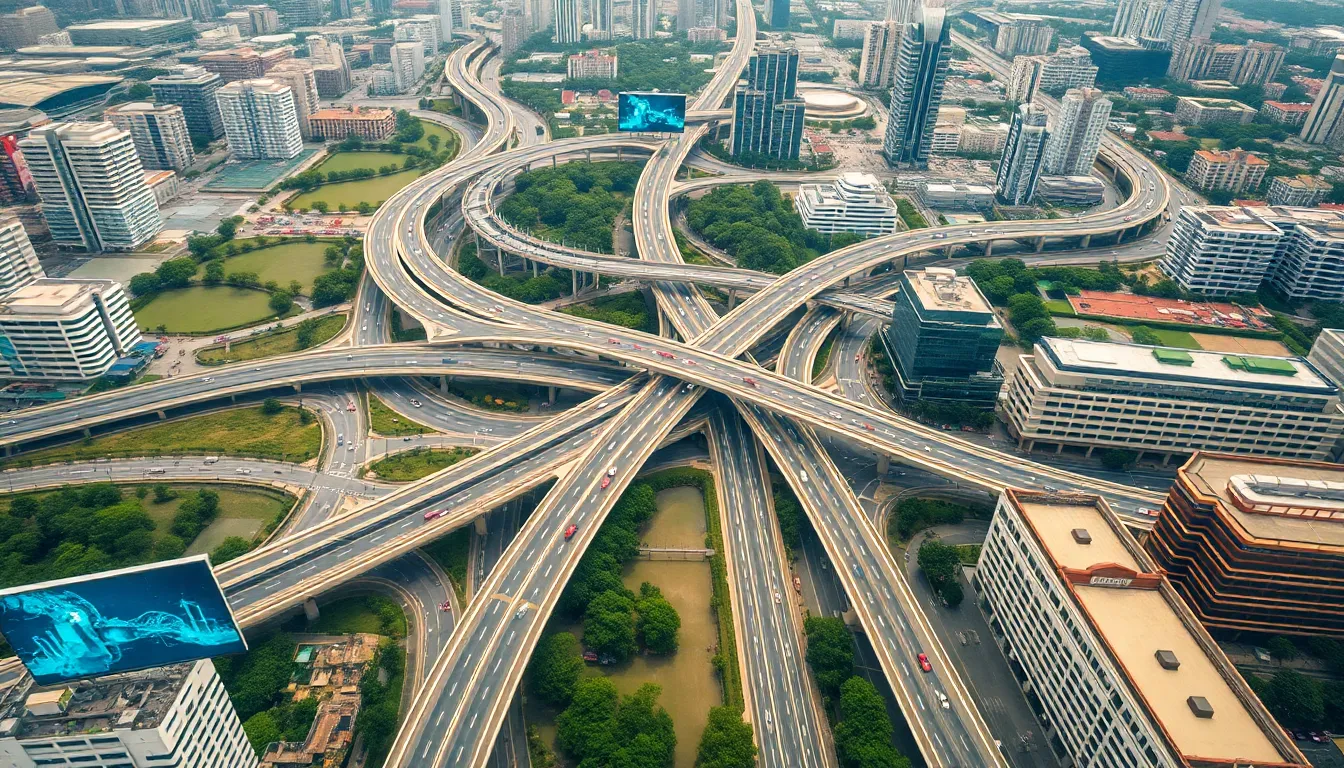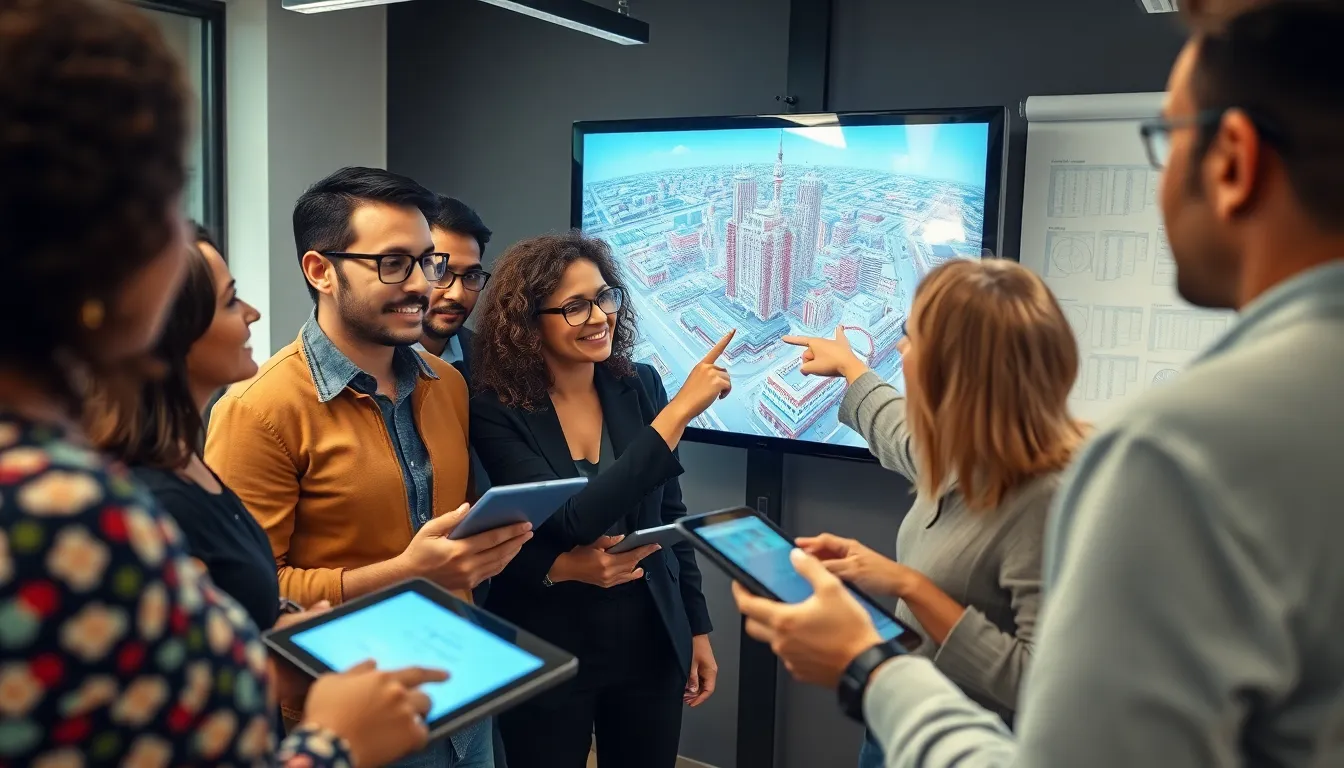Imagine a city that can predict traffic jams, optimize energy use, and even plan for future growth—all before a single brick is laid. Welcome to the world of digital twins in urban planning. These virtual replicas of physical environments are revolutionizing how cities are designed and managed, making urban life not just smarter but also a whole lot easier.
Table of Contents
ToggleOverview of Digital Twins in Urban Planning
Digital twins serve as crucial advancements in urban planning. These dynamic models create a virtual representation of real-world environments to enhance decision-making for cities.
Definition of Digital Twins
Digital twins consist of virtual replicas mirroring physical entities. They integrate data from sensors and IoT devices to simulate real-time conditions. Urban planners utilize these models to assess various scenarios involving infrastructure, utilities, and human activity. By running simulations and analyzing outcomes, planners predict how changes will affect urban spaces. This technology enables a detailed understanding of the interactions between different elements within a city.
Importance in Urban Planning
Digital twins significantly enhance urban planning by improving efficiency. These models allow planners to visualize data trends, leading to better resource allocation. They help identify potential issues before they happen, such as traffic congestion or energy shortages. Additionally, multiple stakeholders can access the digital twin, fostering collaboration among city officials, engineers, and the community. Engaging with this technology encourages data-driven decisions that create sustainable urban environments and improve residents’ quality of life.
Applications of Digital Twins

Digital twins play a pivotal role in enhancing urban planning through their various applications. These virtual models improve real-time decision-making, resulting in smarter city management.
Urban Infrastructure Management
Urban infrastructure management benefits significantly from the implementation of digital twins. They offer detailed insights into the condition of roads, bridges, and utilities. By analyzing this data, urban planners can predict maintenance needs and allocate resources effectively. Moreover, digital twins facilitate scenario modeling, allowing planners to simulate the impact of new projects on existing infrastructures. Predictive analytics help anticipate failures before they occur, reducing downtime for essential services.
Transportation Planning
Transportation planning thrives with the integration of digital twins. They enable real-time monitoring of traffic patterns and public transit usage. Planners can visualize commuter flows and identify congestion hotspots. Insights derived from this data lead to better route optimization and efficient scheduling for public transit systems. Collaboration with stakeholders enhances the ability to devise alternative transportation methods, promoting sustainable mobility solutions. These innovations ultimately aim to improve accessibility and minimize travel times for residents.
Environmental Monitoring
Environmental monitoring utilizes digital twins to maintain a sustainable urban ecosystem. They aggregate data from air quality sensors, weather stations, and other sources. This comprehensive approach allows for the assessment of environmental impact on urban areas. Monitoring changes in air pollution levels and climate conditions facilitates timely policy adjustments. Digital twins also support initiatives in resource conservation, such as water management and waste reduction. Engaging the community in environmental practices becomes more achievable with these advanced monitoring systems.
Benefits of Implementing Digital Twins
Digital twins in urban planning offer numerous benefits that enhance city management and improve residents’ lives. Below are key areas where digital twins significantly contribute to urban environments.
Enhanced Decision-Making
Enhanced decision-making occurs as planners access real-time data with digital twins. Through integrated simulations, they can visualize the impact of infrastructure changes or policy implementations. Predictive analytics further empowers planners to assess potential outcomes before taking action, leading to more informed choices. These virtual models support diverse scenarios, enabling planners to make adjustments based on evolving urban needs. By presenting comprehensive insights, digital twins facilitate collaboration among stakeholders, ensuring every voice contributes to the decision-making process.
Increased Efficiency
Increased efficiency in urban operations stems from the data-driven capabilities of digital twins. Planners utilize these virtual replicas to monitor infrastructure health continuously, identifying possible maintenance needs early. Resource allocation becomes more strategic, as planners can pinpoint areas requiring urgent attention. Transportation systems benefit from improved traffic flow analysis, resulting in optimized routes and schedules. Overall, digital twins streamline urban processes by reducing delays, saving time and costs associated with traditional planning methods.
Improved Community Engagement
Improved community engagement thrives when digital twins facilitate communication between planners and residents. Tools that visualize urban changes allow citizens to grasp the implications of development projects. This transparency fosters a sense of ownership and awareness among community members. Planners can gather feedback through interactive platforms, ensuring that public opinions shape urban strategies. Ultimately, digital twins promote collaborative efforts, enhancing relationships between local authorities and residents while building trust and satisfaction in urban planning activities.
Challenges and Limitations
Digital twins in urban planning face several challenges that can hinder their effectiveness. Understanding these limitations is essential for maximizing their potential in city management.
Data Privacy Concerns
Data privacy concerns arise from the extensive data collection inherent in digital twins. Urban planners gather information from sensors and IoT devices, which may include sensitive personal information. Protecting this data requires stringent security measures and compliance with regulations, such as GDPR. Stakeholders must prioritize the establishment of transparent data usage policies. Ensuring residents’ trust in the technology hinges on clear communication about how data is collected and used. Mismanagement of data can lead to breaches, raising significant legal and ethical implications that planners must navigate carefully.
High Implementation Costs
High implementation costs present a significant barrier to the adoption of digital twins. Organizations face various expenses, including software development, hardware installation, and data management systems. These costs can be substantial, particularly for smaller municipalities with limited budgets. Moreover, ongoing maintenance and updates contribute to the overall financial burden. Funding avenues, such as public-private partnerships, become crucial for overcoming these financial hurdles. Securing investment often involves demonstrating a clear return on investment, which can delay implementation as municipalities assess long-term benefits.
Integration with Existing Systems
Integration with existing systems poses additional challenges in implementing digital twins. Urban planners often work with legacy systems that may not easily support new technologies. Ensuring compatibility requires careful planning and potential system overhauls. Coordination among various departments, each with its own processes and technologies, complicates integration efforts further. Seamless data transfer between systems becomes vital for creating effective digital twin applications. Addressing interoperability issues early in the planning process can enhance overall efficiency and ensure a smoother transition to new technologies.
Future Trends in Digital Twins for Urban Planning
Emerging trends in digital twins for urban planning indicate significant advancements that shape future city management strategies. These trends emphasize the integration of new technologies and collaboration among stakeholders.
Advancements in Technology
Sophisticated technologies drive the evolution of digital twins in urban planning. Artificial intelligence plays a critical role in analyzing vast data sets, improving predictive capabilities, and adapting simulations to real-time scenarios. Virtual and augmented reality enhance visualization, allowing planners to experience environments intuitively. Machine learning algorithms refine data analysis, identifying patterns that lead to better decision-making. Connectivity improvements, such as 5G, facilitate seamless data sharing between sensors and digital platforms. These innovations empower urban planners to create dynamic, responsive models that balance growth with sustainability, ultimately enhancing urban environments.
Increased Collaboration Between Stakeholders
Collaboration among stakeholders is growing in the realm of digital twins. City planners increasingly engage with community members, encouraging feedback in real-time data simulations. Interdisciplinary teams involving engineers, architects, and data scientists work together to devise comprehensive urban strategies. Partnerships with private technology firms provide access to advanced tools and resources. Community participation fosters transparency and trust, ensuring that urban projects align with public needs. Engaging diverse perspectives allows for innovative solutions to complex urban challenges. The result is a more cohesive and resilient approach to urban planning, benefiting cities and their residents.
Digital twins are revolutionizing urban planning by providing innovative solutions that enhance city management. Their ability to integrate real-time data and predictive analytics empowers planners to make informed decisions that improve infrastructure and community engagement. As cities continue to evolve, the adoption of digital twins will play a crucial role in creating sustainable environments that prioritize residents’ quality of life.
While challenges such as data privacy and integration remain, the advancements in technology and collaboration among stakeholders promise a brighter future for urban planning. Embracing these tools will not only streamline processes but also foster a more connected and responsive urban landscape.




